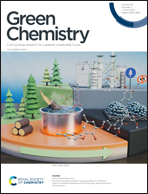Visible-light-driven 3-hydroxybutyrate production from acetone and low concentrations of CO2 with a system of hybridized photocatalytic NADH regeneration and multi-biocatalysts†
Abstract
Poly-3-hydroxybutyrate (PHB)-derived plastics having good biodegradability are attractive materials to solve the issue of serious environmental pollution due to plastic disposal. The production of a new PHB precursor 3-hydroxybutyrate from CO2 and acetone using a visible-light-driven catalytic system consisting of an electron donor, a photocatalytic dye, an electron mediator, and biocatalysts is an environmental approach for both plastic pollution and global warming. In this work, the visible-light driven 3-hydroxybutyrate production from acetone and low-concentration CO2 captured from the gas phase by 4-(2-hydroxyethyl)-1-piperazineethanesulfonic acid (HEPES)–NaOH buffer solution with the combination of a NAD+ reduction system of triethanolamine (TEOA), water-soluble zinc porphyrin, zinc meso-tetra(4-sulfonatophenyl)porphyrin tetrasodium salt (ZnTPPS) and the Rh coordination complex ([Cp*Rh(bpy)(H2O)]2+; Cp* = pentamethylcyclopentadienyl, bpy = 2,2′-bipyridyl), and an enzyme extract including acetone carboxylase (AC; EC 6.4.1.6) and 3-hydroxybutyrate dehydrogenase (HBDH; EC 1.1.1.30) obtained from a purple nonsulfur photosynthetic bacterium, Rhodobacter capsulatus SB1003 (Rb. capsulatus SB1003) cultured in a medium containing acetone and bicarbonate under anaerobic photoheterotrophic conditions was investigated. It was found that acetone can be converted into 3-hydroxybutyrate in high yield (more than 60%) by directly using 15% CO2 equivalent to exhaust gas as a carboxylating agent. Moreover, the development of the visible-light driven 3-hydroxybutyrate production from 15% CO2 and waste acetone as raw materials was also accomplished.



 Please wait while we load your content...
Please wait while we load your content...